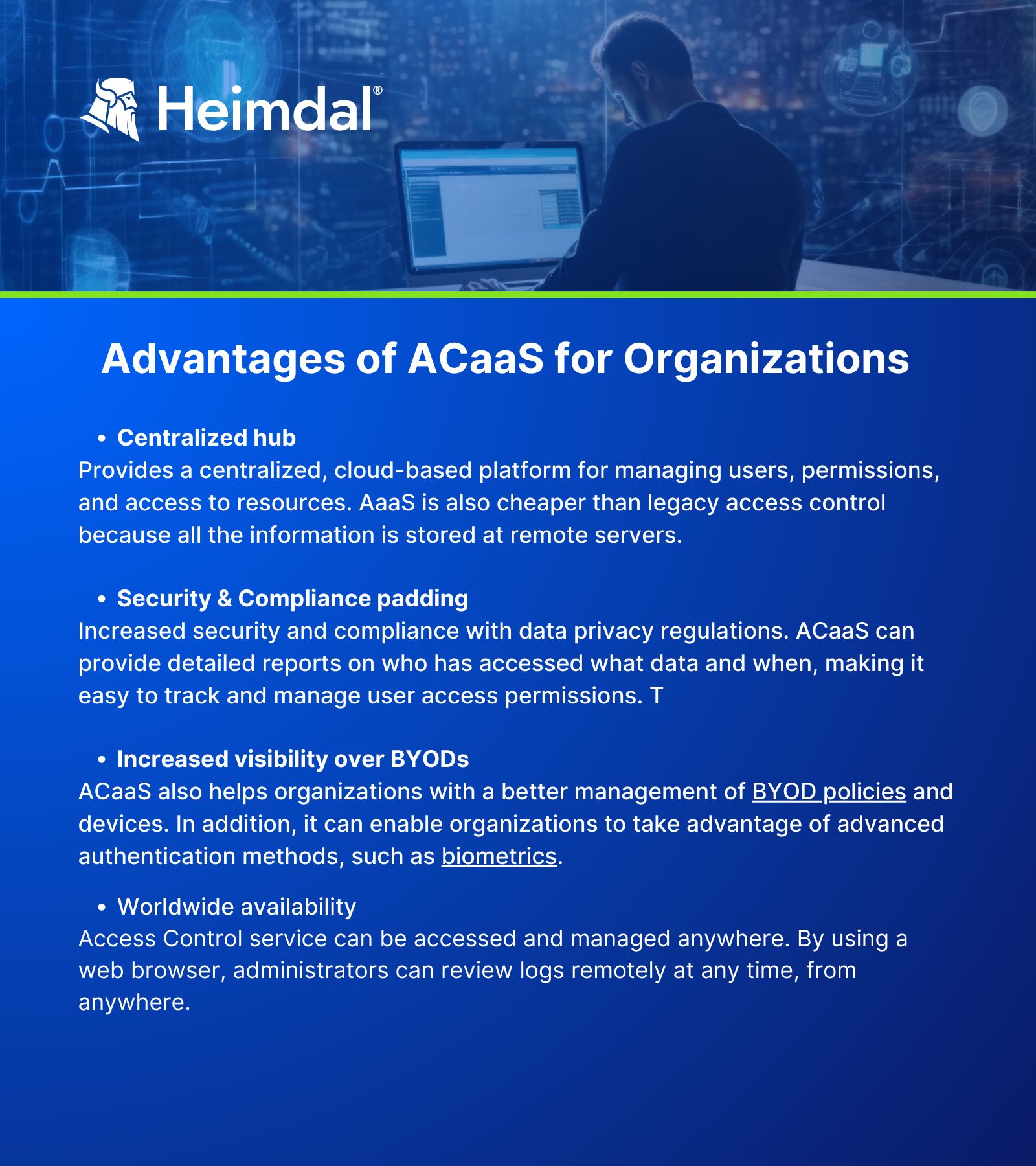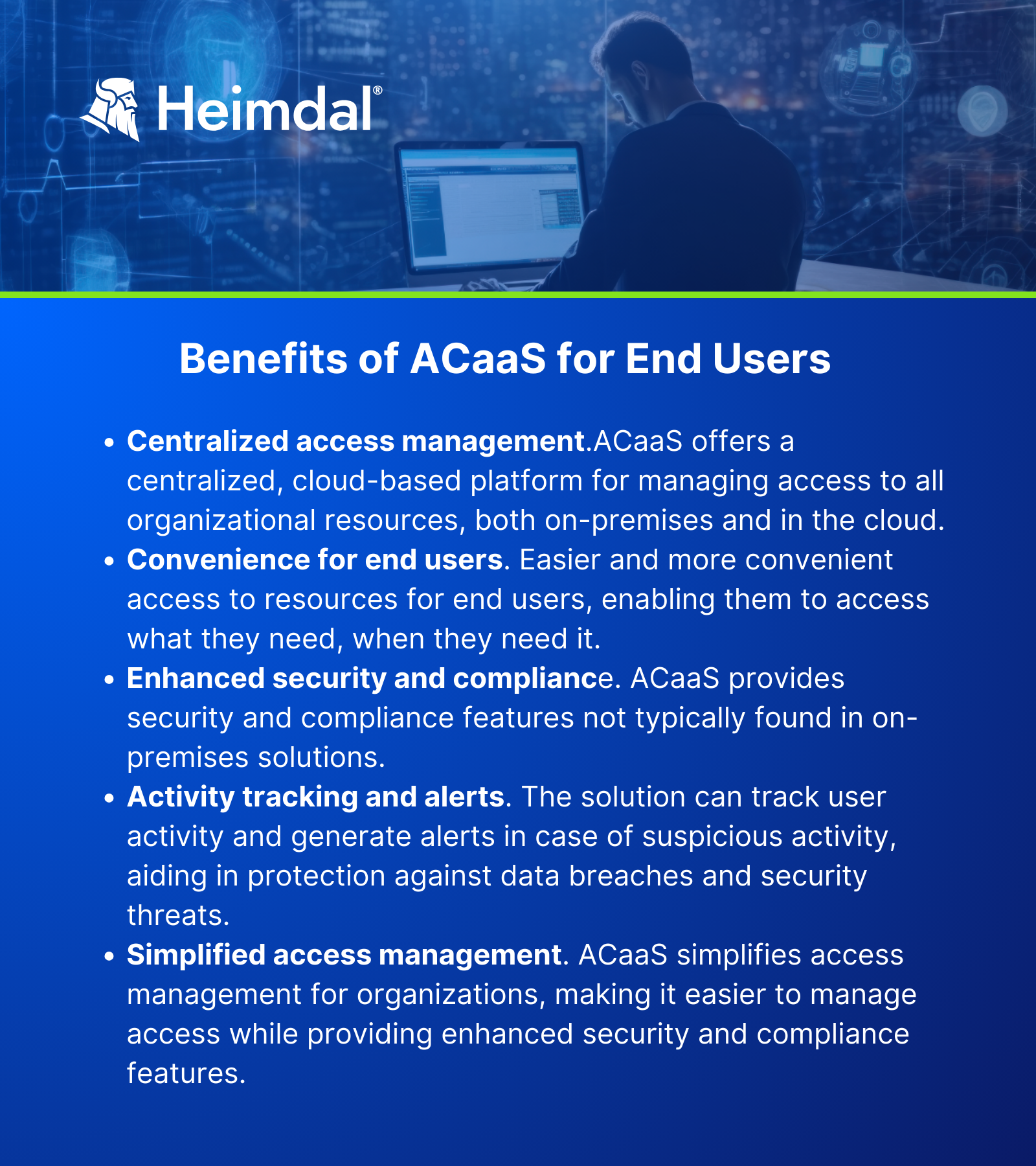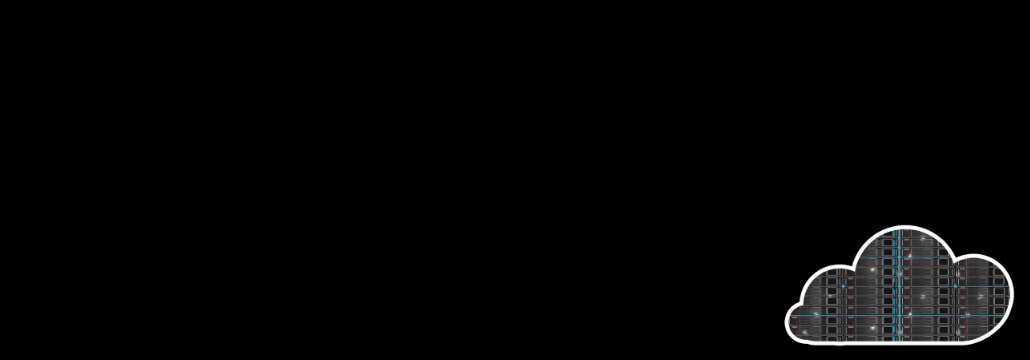Contents:
Access Control-As-a-Service(ACaaS) is a cloud based solution that provides all the benefits of traditional access control systems without relying on on-prem hardware or software.
In this article, we’ll explore why ACaaS is the future of Identity and Access Management (IAM) and how it can help your organization stay safe.
What you’ll find in this article.
- What Is Access Control as a Service?
- Advantages of ACaaS for Organizations.
- Benefits of ACaaS for End Users.
- Challenges and Limitations of Implementing ACaaS.
- Security Considerations When Implementing Access Control Systems
What Is Access Control-as-a-Service?
Access control is a critical security measure for any organization, yet it can be difficult and expensive to manage, especially when it comes to access control hardware. This is where Access Control-as-a-Service (ACaaS) comes in.
ACaaS is a cost-effective access control system solution that is easy to deploy in controlled areas and manage as opposed to traditional access control solutions.
Briefly put, some of the key benefits of Access Control-as-a-Service include:
- Flexibility. It can be easily customized to meet the specific needs of your organization.
- Scalability. Quickly scale up or down to accommodate changes in your organizational needs.
- Security: ACaaS provides comprehensive security features, including user authentication, authorization, and auditing.
- Efficiency. ACaaS reduces the time and effort required to manage access control by via automation.
Advantages of ACaaS for Organizations
Access Control as a Service has several advantages over traditional access control.
Centralized hub
Provides a centralized, cloud-based platform for managing users, permissions, and access to resources. This can simplify and streamline IAM processes for organizations of all sizes.
AaaS is also cheaper than legacy access control because all the information is stored at remote servers.
Security & Compliance padding
Increased security and compliance with data privacy regulations.
ACaaS can provide detailed reports on who has accessed what data and when, making it easy to track and manage user access permissions.
This is vital for complying with GDPR requirements around data privacy and security.
Increased visibility over BYODs
ACaaS also helps organizations with a better management of BYOD policies and devices.
In addition, it can enable organizations to take advantage of ancillary access control technologies, such as those related to physical security (e.g., video surveillance, biometrics).
Worldwide availability
Access Control service can be accessed and managed from multiple locations. By using a web browser, administrators can review logs remotely at any time, from anywhere, via a secure connection to the data centers.

Benefits of ACaaS for End Users
The benefits of Access Control-as-a-Service (ACaaS) reach end users as well.
ACaaS provides a centralized, cloud-based platform for managing access to all of an organization’s resources, both on-premises and in the cloud.
This makes it much easier and more convenient for end users to access the resources they need, when they need them.
This solution can track user activity and generate alerts if suspicious activity is detected. This helps to protect against data breaches and other security incidents.
Overall, ACaaS provides a number of advantages for both end users and organizations. It simplifies access management while also providing enhanced security and compliance features.

Challenges and Limitations of Implementing ACaaS
As organizations turn to ACaaS solutions, they face many implementation challenges as well as limitation in how they manage access control.
ACaaS Challenges
1. Integration.
Ensuring that the solution integrates with existing security systems (CCTV and intrusion detection).
2. Scalability.
Ensuring that the system is scalable, so that it can accommodate future growth.
3. Identity & permissions management.
Considering how they will manage user identities and permissions within the ACaaS system.
4. Compliance.
Ensuring that the ACaaS solution meets all relevant compliance requirements. Failure to do so could result in hefty fines or other penalties.
ACaaS Limitations
While ACaaS provides many benefits over traditional on-premises access control systems, there are some limitations to consider.
1.Reliance on the internet connection.
If there is an interruption in internet service, ACaaS systems will not be able to function .
2. Compatibility issues.
ACaaS providers may not support AC-specific hardware or some types of access control technology on the market.
3. Price range.
Access control as a Service solutions can be more expensive than traditional on-premises systems.
Integrating with Existing Systems for Access Control
Many organizations have legacy systems that they’re unwilling or unable to replace. In these cases, it’s important to find an access control solution that can integrate with existing systems.
There are a few different ways to go about this.
Access control bridge
Use an access control bridge, which is a hardware device that connects the new system to the old one. This allows you to keep using your existing system while also taking advantage of the features and benefits of the new system.
Software integration
Use software that integrates with your existing system. This approach can be less expensive than physical access control systems.
Yet, it may require more technical expertise to set up and maintain. Whatever approach you take, it’s important to make sure that the new system is compatible with the old one before making any changes.
Otherwise, you could end up with an access control system that doesn’t work properly or causes other problems for your organization.
Security Considerations When Implementing Access Control Systems
Security is always a primary concern when it comes to access control, and ACaaS is no exception. Here are some key considerations to keep in mind when evaluating ACaaS solutions.
- Authentication: How does the solution authenticate users? What types of credentials are supported? Can it support mobile credentials?
- Authorization: How does the solution determine which users have access to which resources? What type of granularity is available? How do you grant access?
- Audit: Does the solution provide comprehensive auditing capabilities for the entire system? Can audit logs be exported for further analysis?
- Security Monitoring: Does the solution provide real-time monitoring of activity on the system? Are alerts configurable to notify administrators of suspicious activity?
- Data Protection: Is sensitive access control data encrypted at rest and in transit? Are there mechanisms in place to prevent unauthorized access to data? How do you store data securely?
How Can Heimdal® Help?
The Heimdal Privileged and Access Management solution is great for many reasons, but here are the most important ones:
- if paired with our Next-Gen Antivirus & MDM, it automatically deescalates user permissions on threat detection;
- it gives you flexibility in the approval/denial flow since you can grant or revoke permissions from anywhere in the world;
- it gives you power over what happens during an elevated session and stronger security against insider threats;
- it supports Zero-Trust execution;
- you can remove local admin rights using Heimdal PAM, thus closing off OS and web vulnerabilities;
- you can prove compliance with NIST AC-5 and NIST AC-1,6.
What’s more is that it works even better when paired with Heimdal Application Control, which allows you to whitelist or blacklist applications based on file path, publisher, certificate, vendor name, software name, MD5, and more.

Heimdal® Privileged Access Management
- Automate the elevation of admin rights on request;
- Approve or reject escalations with one click;
- Provide a full audit trail into user behavior;
- Automatically de-escalate on infection;
To Conclude…
Access Control-as-a-Service is the future of Identity and Access Management, as it provides organizations with greater control over their access management systems. It also allows organizations to reduce costs while still ensuring that they have the highest levels of security in place.
Additionally, ACaaS can be used to provide more flexibility and scalability for organizations of all sizes, making it an attractive option for companies looking for a secure IAM solution.
With its vast array of benefits, it’s easy to see why Access Control-as-a-Service is becoming the go-to choice for many businesses today.
If you liked this article, follow us on LinkedIn, Twitter, Facebook, and YouTube for more cybersecurity news and topics.


 Network Security
Network Security
 Vulnerability Management
Vulnerability Management
 Privileged Access Management
Privileged Access Management
 Endpoint Security
Endpoint Security
 Threat Hunting
Threat Hunting
 Unified Endpoint Management
Unified Endpoint Management
 Email & Collaboration Security
Email & Collaboration Security










